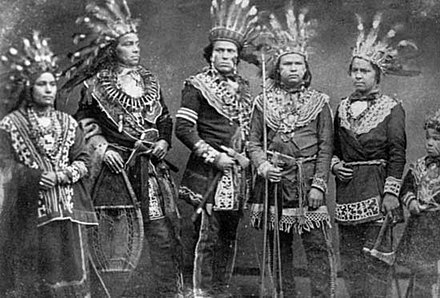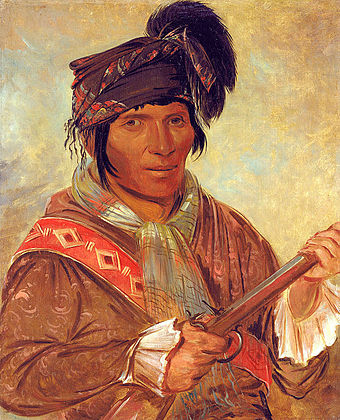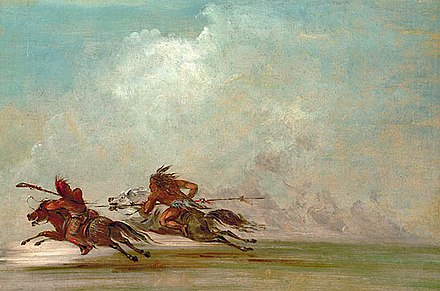 Tribe
Tribe: Menominee
Territory: Wisconsin
Current Status: Still around
Population (approx): 8.700
Not at all warlike, the Menominee (doo-doo-bi-doo-doo - sorry) were known for being peaceful and getting on with other tribes, and were not involved in any wars or territorial conflicts, despite owning a huge territory of over ten thousand acres. You’d have to wonder, given how peaceful they are supposed to have been, why some other more warlike tribe did not try to take this land from them, but it doesn’t seem to have happened (until, of course, the biggest and most warlike of all tribes arrived in their land).
 Tribe:
Tribe: Anishinaabeg (including Algonquin, Nipissing (hur hur), Ojibwe, Mississaugas, Saulteaux, Odawa, Potawatomi
Territory: Michigan, Minnesota, Wisconsin, Indiana, Ohio, Illinois, Oklahoma, Kansas
Current Status:: Still around
Population (approx): in excess of 370,000
Yes that’s a s
hitload of peoples to put under the one banner, but come on: there are hundreds of separate tribes and I don’t intend to write about all of them. They’re all seen to come under the basic banner of the Anishinaabeg anyway, otherwise I’d be treating them separately. At any rate, it seems the Anishinaabeg consider the Abenaki to be their ancestors, and call them “the Fathers”, except for the Cree, but you know what they’re like.
Tribe: Assateague
Territory: Maryland
Current Status:: More or less extinct
Population (approx): 0
These fine chaps had the idea to removed the flesh and organs of the dead before they buried them, actually storing the bones of their ancestors in long huts for years. Charming. Although there may be some still living who can trace their heritage to the Assateagues, the tribe as such is no longer extant.
Tribe: Chowanoke
Territory: North Carolina
Current Status:: More or less extinct; current descendants trying to renew their tribes
Population (approx): Unknown
In their time the most powerful tribe in North Carolina, the Chowanoke had a leader and a noble class, according to evidence found by archaeologists, as well as temples and burial grounds.
Tribe: Choptank:
Territory: Maryland
Current Status:: Extinct
Population (approx): 0
Not much I can tell you, except that to my knowledge none of them ever chopped a tank.
 Tribe
Tribe: Shawnee
Territory: Ohio, Virginia, West Virginia, Kentucky, Pennsylvania, Oklahoma
Current Status: Still around
Population (approx): 14,000
A well-known name thanks to movies, the Shawnee practiced burial of their people in mounds (not literally practiced: I don’t mean they had dry runs with live specimens or anything! All right braves, that’s a wrap! We’ll pick it up again tomorrow!) and also built effigy mounds, one of which still stands in Ohio, the Great Serpent Mound in Adams County. They believed the Lenape people to be their grandfathers, their greatest and most famous leader being Tecumseh, whose name would be given to the great Civil War general Sherman. The Shawnee, unlike many of the tribes, were patrilineal, though for some reason their kings were chosen through the matrilineal line. Odd.
 Tribe
Tribe: Cherokee
Territory: North and South Carolina, Tennessee, Alabama, Georgia, Arkansas, Texas, Mexico, Oklahoma
Current Status: Very much still around
Population (approx): Over 1 million
Who hasn’t heard of these? Along with the Apaches and the Comanches they’re probably the best known tribes, again thanks to Hollywood, TV and books. Their names still exist - apart from in their own tribes - in products such as jeeps, aircraft and sports teams, and despite their usage in western movies as the bad guys, the Cherokee actually believed war to be a polluting activity, preferring to farm and hunt. For this reason they had two councils of elders, one, the “white” council, looked after their spiritual well-being, taking care of prayers, healing, purification and so forth, while the “red” council - staffed by younger men - was in charge of preparations for war. After the battles, the men had to be spiritually cleansed by the white council before they could be reintegrated back into society.
Though a matrilineal society, polygamy was practiced among the Cherokee, especially the elite men; this was not seen as a bad thing, nor did it disrespect women, who were held in very high regard among the tribe. Women owned the land and the home, farmed and chose the leaders of the tribe. They were also expected to keep the cultural history of the people alive, being its guardians. Cherokees are of course identified with the Trail of Tears, but that’s much later and we’ll be looking at that in detail when the time comes.
 Tribe
Tribe: Seminole
Territory: Florida, Oklahoma
Current Status: Still around
Population (approx): 18,600
They seem to be one of the younger tribes, only coming into being around 1700, and technically then not so much affected by the incursion of the white man, or to be more accurate, they didn’t enjoy the freedom that other tribes did, as they weren’t in existence at the time. Perhaps I’m reading this wrong, but they appear to be one of the very few tribes that actually increased rather than declined in population, beginning with about 4 ,000 - 6,000 of them in the nineteenth century and now with today almost five times that.
 Tribe
Tribe: Apalachee
Territory: Florida
Current Status: Still around
Population (approx): 300
It seems these fellas invented the modern game of football, including rules governing its (mis)conduct.

Didn’t quite get it right though. They kicked the ball - made of dried mud covered with buckskin - against the goalpost (there was no net), and points were scored if you hit the post (unlike now, when it’s a goal opportunity missed) as well as if you could kick the ball into the nest which would be put atop the post, complete with a stuffed eagle. Whether the stuffed eagle was real or not I don’t know. I doubt the Apalachee, or any Native Americans, were familiar with taxidermy, so maybe it was an effigy? Anyway, you got more points if you kicked the ball up onto the goalpost and into the nest. But the best thing were the rules of strategy.
Players would fall upon whoever fell during the game, walk on him, kick him in the face, punch him, stuff dirt in his mouth and pull his arms and legs. A red card offence, surely, ref! Whoever had the ball was told (presumably by the chief/manager) to die before he let it go. Players would hide the ball in their mouths and be choked or punched to get them to release it. There were forty or fifty men per team, and bones were broken and even some deaths resulted. Many matches ended in full-scale riots. Just like today, then. As well as this, good players would be given the best houses, goods and excused from any misdemeanours in order to keep them on the team. So again, just like today.
“Welcome, and you join us at the start of the seventh round of the All-Nations postball tournament, where the two villages of Mudflat and Deerhide are fighting it out for the trophy. We’re all expecting great things from Kicks-in-the-Teeth, Mudflat Village’s to scorer, who has two deaths to his tally and has broken more bones than any other player in this tournament, some even on the opposition side. Bought from Riverside Village for the then-unheard of transfer fee of seven runner beans, Kicks-in-the-Teeth has had a controversial career, including four quashed convictions for robbery, which the village elders ordered hushed up lest he be tempted to move to the rival Deerhide team. That’s professional postball for you; the fans will forgive anything. Now, let’s settle back for what promises to be an entertaining, not to say necessarily lethal, final.”
As you’ve probably worked out by now, the name of this tribe gives rise to the cultural region now known as Appalachia.
 Tribe
Tribe: Blackfoot
Territory: Montana
Current Status: Still around
Population (approx): 130,000
An actual confederacy of originally three, now four Blackfoot-speaking nations, they occupied large swathes of what were then the Great Plains, and had warrior societies, into which only the bravest could be inducted. Blackfoot hunted the buffalo on horseback, though originally they had a less sophisticated method of killing the animals. This was called the buffalo jump, and involved the Blackfeet driving the herd over a cliff, where later they would descend and take what they needed from the mangled corpses. They also developed, or at least used, camouflage, draping buffalo skins over them to disguise their scent while they hunted the beasts. The women would process and prepare the carcasses for food and clothing and other uses.
Every part of the buffalo was used, nothing went to waste, not even its dung, which was used, dried, to light and fuel fires. The skins were draped over the sides of the teepees to keep them warm in winter and cool in the summer, and protected them against wind. The heart was usually eaten by the hunters soon after the animal was brought down, the stomach and bladder used for storing liquid, and the fat for making soap.
The Blackfoot were one of the warrior tribes mentioned earlier, and they placed great store upon bravery, using the method known as “counting coup”, which involved doing various brave things behind enemy lines, such as taking a weapon, killing an enemy or loosing a horse, all of which added to a warrior’s reputation. Among their enemies were some of the bigger and more well-known of the Plains tribes - the Crow, Cheyenne and Sioux.
In midsummer, all four nations would convene for the Sun Dance, a ceremony of spiritual healing. Here they would pray to the creator for good and successful hunting and health. Women were highly valued in the Blackfoot nation, weaving quilts, decorating shields, helping prepare their men for battle, taking care of the children and bringing them up in the traditions of the tribe, and of course as already mentioned, turning the buffalo the men brought home into everything from edible meat to clothing.
Marriage was a slightly more complex deal among the Blackfoot. Although a man could choose a wife, she had to accept him and her decision would also hinge on whether or not her prospective husband could impress her father with his deeds of bravery. The marriage had to be blessed by the girl’s father. One thing Hollywood got right is that some - not all - Native Americans did wear headdresses, and the Blackfoot were one of these, possibly due to its being so cold out on the Great Plains. The headdresses were usually made either from eagles’ feathers or from a bison horn attached to a felt hat.
 Tribe
Tribe: Cheyenne
Territory: Montana, Minnesota, North and South Dakota, Oklahoma, Colorado
Current Status: Still around
Population (approx): 22,970
Another well-known tribe, also of the Great Plains, they too hunted the bison. One of their greatest prophets, known as Sweet Medicine, predicted the coming of the white man. It was believed he had received the sacred arrow bundle and the sacred buffalo hat which are two of the most important holy relics in the Cheyenne nation. In the beginning they ate fish and crops, but the prophet convinced them to switch to a diet of bison meat - and so began the hunt - as well as wild fruits and vegetables. Another warrior society, the Cheyenne are the first I’ve heard of who used the tomahawk, something made almost ubiquitous in western movies and series; among their enemies they numbered the Crow and Blackfoot, Sioux and Pawnee. They also took on the Apache and the Comanche, though they allied with the Arapaho. They would later ally with the Sioux in the Battle of the Little Big Horn.
 Tribe
Tribe: Comanche
Territory: Texas, New Mexico, Kansas, Colorado, Oklahoma
Current Status: Still around
Population (approx): 17,000
Once the greatest and most powerful tribe on the southeast plains, the Comanches commanded a huge area and warred upon other tribes, and are believed to have been the first of the plains tribes to have acquired and used horses, which became absolutely integral and vital to their way of life, and turned them into even fiercer warriors than they already had been. They would also end up making something of a living as horse traders. Comanche boys learned to ride a horse literally before they could walk, and were expected and hoped to grow up and be great warriors, while girls were shown by their mother how to do household tasks and carried a doll made of deerskin that they must learn to make the clothes for, in preparation for their lives as a warrior’s wife. Comanches did not believe much in discipline, but instead led by example, though if punishment was required they would sometimes, um, dress up as ghosts and frighten the children, particularly with the story of Big Maneater Owl, who caught naughty children and ate them. How original.
Boys were expected to be able to ride and handle a horse before they were five years old, and were given small bow and arrow weapons to familiarise themselves with the real thing. As their fathers would most likely be out on a hunt or a raiding party, the boy would tend to identify more with his grandfather, who would be his mentor, trainer and teacher, and show him all the things he needed to know in order to grow up and be a brave warrior. No matter his age though, no boy was allowed go on a war party unless he had distinguished himself on a buffalo hunt. Then there was a great feast thrown for him by his father. Girls were taught at age twelve how to cook, sew clothes, prepare hides and other womanly duties, and were at this age considered eligible for marriage.
When a warrior died, his body was wrapped in blankets and placed on a horse, and taken to a secure cave or other burial site. On return, the rider who had taken the corpse on its last journey would slash his arms in honour of the deceased, and all of the dead man’s possessions would be burned by the village.
Horses were the status symbol within the Comanche nation, a man’s worth measured by how many horses he had. Raiding parties would often go in search of horses to steal, and other than the advantage horse-mounted attack gave the tribe, the animal was respected as it ate no meat, unlike dogs, and so the food that was to nourish the tribe did not have to be shared with the beast of burden. Another thing they took pride in was their hair, which they wore long and hardly ever cut, in two long braids. Unlike other plains natives they did not wear headdresses, or indeed anything on their heads. Women did the opposite to their men, wearing their hair short, apart from very young women, who might keep it long and braided until they were older.